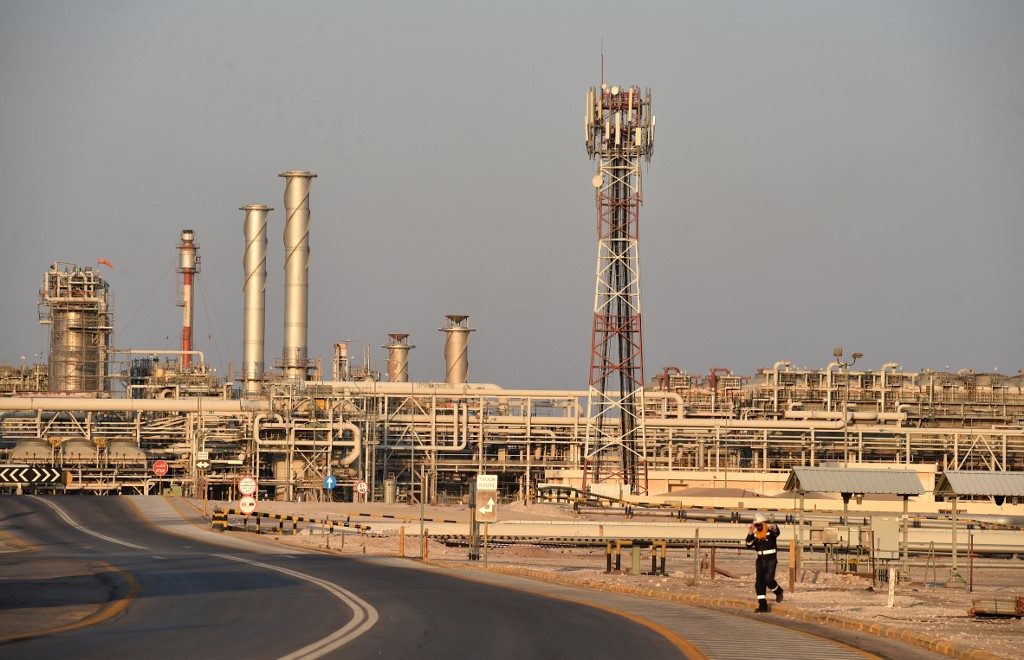SUMMARY
This is AI generated summarization, which may have errors. For context, always refer to the full article.

PARIS, France – A long-awaited, mega stock listing of Saudi oil giant Aramco has prompted questions about its true value owing to geopolitical risks, and the future of oil in general.
Often billed as the world’s most profitable and valuable company, Aramco plans to float 2% of its shares on the Riyadh stock exchange by the end of the year, and would appear to be a must-have stock, for institutional investors in particular.
But the overall market capitalization estimate of $2 trillion for Aramco based on a forecast the initial public offering (IPO) could raise around $100 billion has been lowered by major investment banks that highlight several mitigating factors.
A trillion or two?
Saudi Crown Prince Mohammed bin Salman (MBS) wants to pry open the kingdom’s economy to fund what he calls Saudi Vision 2030 aimed at diversifying it away from a dependence on crude oil revenues.
But Bloomberg news agency quotes international banks as warning the prince’s estimate of Aramco’s value could end up being somewhat lower than $2 trillion, with BNP Paribas penciling in $1.42 trillion and HSBC looking at a range of $1.59 to $2.1 trillion.
Now, MBS “is looking for a valuation between $1.6 to $1.8 trillion, meaningfully less than the $2 billion targeted earlier. But even that could be a hard target to reach,” remarked Ipek Ozkardeskaya, an analyst at the London Capital Group.
She highlighted waning global demand for oil and a drop in oil prices as key reasons why investors might not want to pay top dollar for Aramco shares.
CMC Markets analyst Michael Hewson pointed out that even a smaller IPO “would still make Aramco the world’s most valuable company, putting it above both Apple and Microsoft who both have $1-trillion valuations.”
Aramco posted a net profit of $111.1 billion in 2018, a jump of 46% from the previous year, and annual revenues of $356 billion as it pumped around 10% of the world’s crude oil.
No foreign listing for now
Sector experts say the IPO is planned in two stages, first on the Saudi stock market, followed by one next year of around 3% of Aramco’s shares on a major global exchange, with London and New York tipped as leading candidates.
Some reports have suggested however that institutional investors have questions over the company’s transparency and governance.
On Sunday, November 3, Aramco chairman Yasir al-Rumayyan said in a statement: “For the [international] listing part, we will let you know in due course.”
Neil Wilson at Markets.com noted that “this kind of listing requires a major exchange to provide the sheer scale of liquidity that it will gobble up.
“Can the market even handle the incredible amount of liquidity that this listing will require?” he asked.
Political risk
“Aramco will clearly not be for every investor,” said analysts at the Alliance Bernstein money management company.
A major risk at present comes from regional instability, underscored in September by drone attacks on two Aramco installations that briefly cut Saudi output in half.
“While geopolitical events like these tends to support prices, direct attacks on facilities owned by an oil company are rather different matters for investors,” Wilson remarked.
The launch of shares in Riyadh will thus provide an insight on how investors feel about the company’s future overall.
On Sunday, the long-awaited IPO announcement failed to spur the Riyadh market, which closed almost 2% lower.
The future of oil
Ironically, to succeed, the share listing must spur investors’ appetite for oil assets even though the goal is to prepare for a future when oil will be less important.
“It is hard to put a number on a company that generates all of its income by way of fossil fuels, where supply is already plentiful, and whose use is already in decline, as renewables become more mainstream,” Hewson commented.
Wilson noted that “in terms of the outlook on oil prices, it’s hard to see much improvement.
“Demand growth is slowing, while supply is really not a problem.”
With barrels of crude oil trading for around $60, the sector is far from record highs of more than $140 set in 2008. – Rappler.com
Add a comment
How does this make you feel?
There are no comments yet. Add your comment to start the conversation.